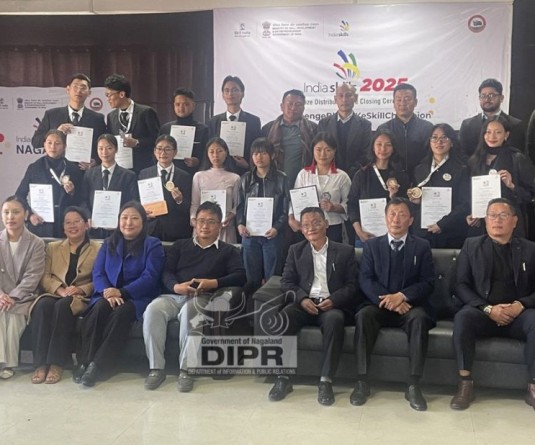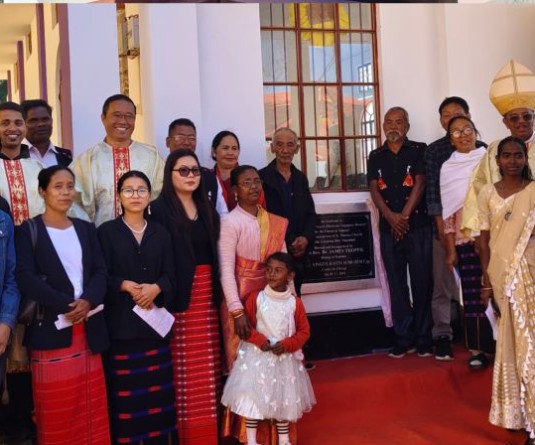Samhita Barooah
Deccan Herald
August 24
Villages such as Chizami in Nagaland seem to have answers to food security, health security and even the adversity that climate variations bring
Walking through the lush green terrace fields in remote Chizami village in Nagaland makes one feel the freshness of the land. It is a long trail through the forest, steep slopes and then right across the terrace bunds, one finally reaches the farms. A farmer here has to take a steep walk for about five km to reach his farm.
The Chakhesang community known for their Jabo Kheti or terrace cultivation has inhabited the Phek district of Nagaland in North East India. Jabo Kheti is one of the most sustainable forms of agricultural practices in the hilly terrain. There are no tube-wells, lift irrigation technology or jet pumps, no tractors and oxen. A farmer here uses only a spade to work in these fields. Simple, yet meticulous methods of land distribution and wise water management plan chalked out by farmers make farming still possible. Split bamboo channels run through the fields and the water sources (natural springs) from the higher slopes provide adequate supply of water for the crops.
Traditional knowledge, innovations with cropping patterns and cohesive community farming techniques make agriculture possible here. One slope of terrace field serves almost 10 families. On an average, one family has six to eight members. During a good rainy season, these fields can yield enough crop to sustain the families.
Paddy is grown as a primary crop in the terrace fields, and it is the staple diet for people in this region. However, it is not just monoculture where a single variety of paddy is grown. There are around 20 varieties of paddy grown here. The fields also have corn, sesame, millets and diverse types of vegetables and pulses as reserve crops in case paddy fails. Some crops, which are part of the first batch of the winter harvest are potato, Naga onion, pumpkin, tomato and mustard leaves. There is an ecological balance maintained by the water algae, which spreads across the field after farmers here harvest paddy. The algae maintain soil fertility for the sowing season. In these watery fields, one finds fish, snails and crabs that add protein to the diet.
Farmers grow pigeon pea, some other varieties of pulses (Naga dal) and small trees with soil binding capacity by terrace field bunds, to check landslides. The water for these fields is equally distributed.
There are strict rules followed by the farmers from every clan to keep the height of the water inlet at the same level for every terrace field so that there is no imbalance in the distribution of water. Farmers follow these rules made by their ancestors and handed down through the generations.
There are three types of land which people here own. Individual terrace land for wet cultivation, Jhum land or land used for dry cultivation on the steep slopes using the slash and burn method of cultivation and the most important part is the reserve of clan and community forestlands, owned by every village. Alder trees are the most important for farmers, and are considered their best friend. The Alder tree has deep root nodules which help in fixating nitrogen, and farmers believe that this increases crop yield and also reduces soil erosion. Farmers do not cut the tree from the root or the stem; they cut only the branches from the top and make use of the wood. This process helps the tree to re-grow fast.
To ‘jhum’ or not to ‘jhum’?
Jhum cultivation as an agricultural practice is considered devastating for forests by many researchers and journals, and has often come under criticism. Nevertheless, there are some treasures of Jhum cultivation specific to this place.
Jhumming provides the foundation for crop diversity. The number of crops grown in the jhum fields touches an average of more than 30 varieties, which includes millets, tubers, vegetables, spices like ginger and garlic, and pulse varieties. These Jhum fields act as nurseries for paddy before the farmers transplant them into the terrace fields. No doubt, with the rising pressure for food, the Jhuming cycles are coming down to five-six years, which is indeed very alarming. However, in the old times, the fallow period in a Jhum cycle was 10-12 years, which helped the process of re-growth of the secondary forest.
In Chizami and its neighbouring villages, it is a combination of Jhum and terrace cultivation, which farmers practise . This helps to sustain the food and nutritional needs of the people. Moreover, the forests provide the necessary rains, flora and fauna to maintain the perfect ecological balance.
Chakhesang sets an example
These villages seem to have answers to food security, health security and even the adversity that climate variations brings. In a world where climate change debates are increasing, many farmers are resorting to high yielding varieties; GM and transgenic crops and chemical fertilisers, the Chakhesang community in Nagaland is producing diverse crops through sustainable practices. There are many such communities in India that still practise sustainable agriculture but are yet to be recognised.
Community members, mostly women farmers from Chizami and its neighbouring villages recently participated in the national consultation of the climate community charter organised by different groups from across the country.
A woman from the community Seno Tsuhah also represented her people while presenting the climate charter at the Copenhagen World Climate Conference held in December 2009. “While the world leaders were debating whether there is any evidence of climate change or not, I thought about how my community members prepared every year for the change in climate and devised local methods to combat such variations. We should be aware of our own storehouses of knowledge and practices where the answers to many provocative questions lie,” she remarked.




